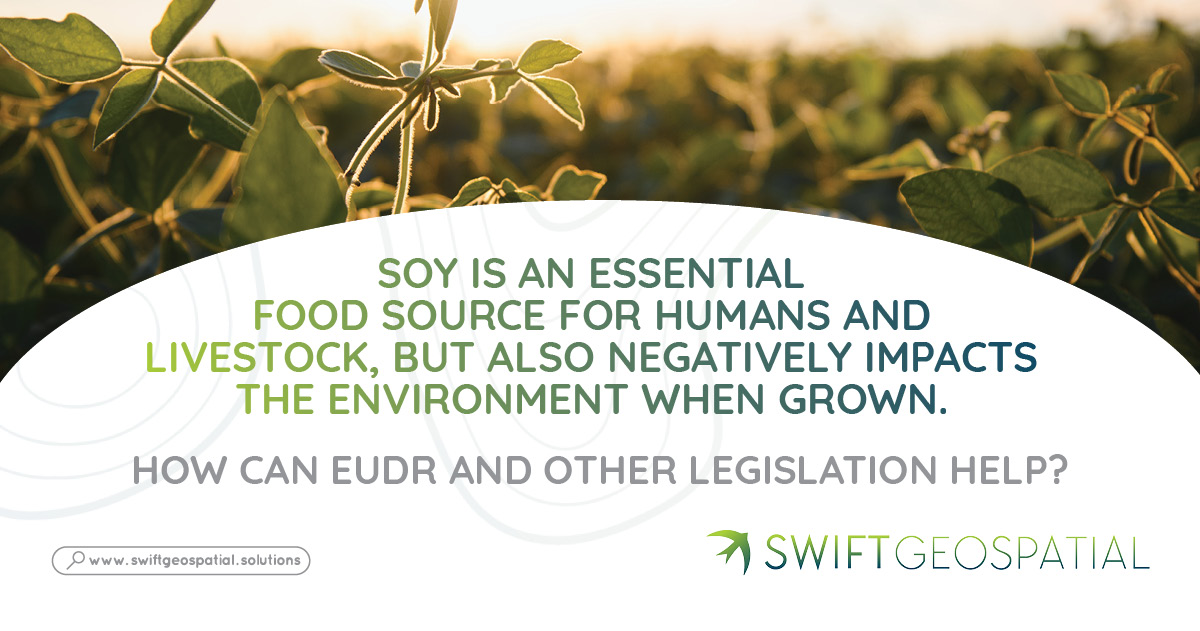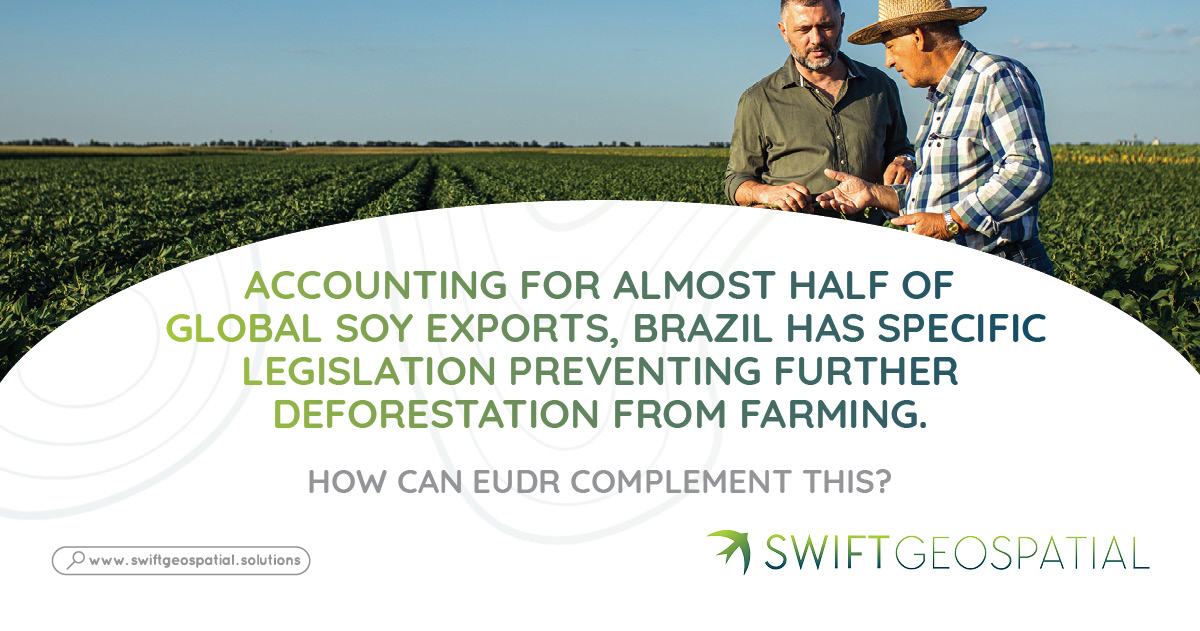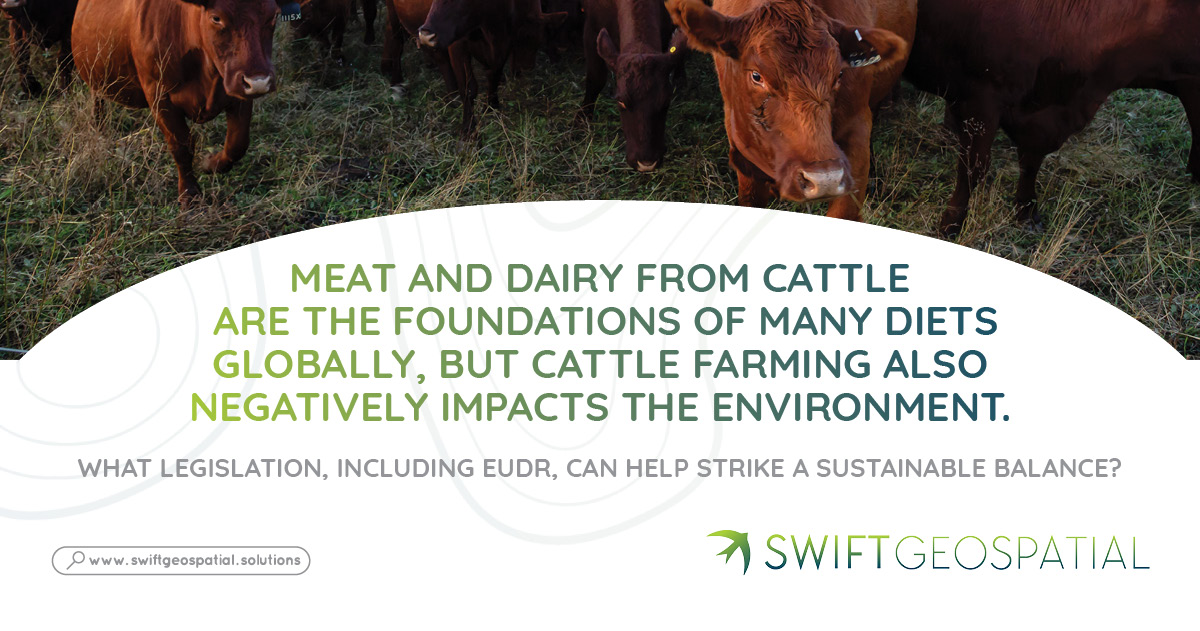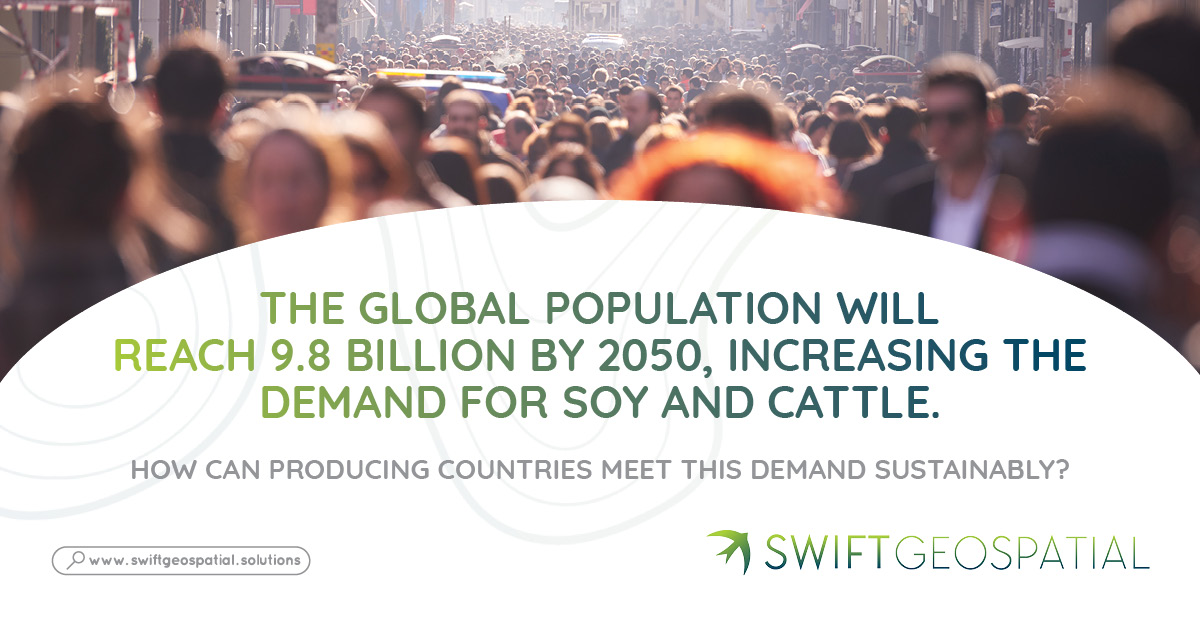As global demand for soy and cattle increases, how can EUDR and other legislation help prevent negative climate impacts?
In a world where deforestation management and climate conservation are becoming increasingly pressing, soybean production and cattle farming are being spotlighted. Not only are they both listed as top deforestation drivers under the European Union Deforestation Regulation (EUDR), but soybeans are a key component of animal feed, with reports that 75% of the world’s soy production is used for this purpose.
In key soybean cultivation zones like South America, areas once used for cattle ranching activities are now being replaced by soybean farms due to growing global demand, displacing pastures further into forested areas and resulting in deforestation.
But why the growing demand for soybeans over other crops? Soy protein contains all nine essential amino acids for the human diet and important nutrients like B vitamins, potassium, magnesium and high-quality protein. This high protein content, alongside other benefits, makes soy an attractive food source for both human and animal consumption on top of being a more affordable protein source. In an effort to reduce environmental impact and climate change, there has also been a growing global focus on producing meat- and dairy-free alternatives, with developed countries like Australia, Canada and Japan seeing declines in CO2 emissions related to meat products due to the consumption of these alternatives. Soya is an essential ingredient in these, and as more countries adopt a meat-free mentality, demand will only continue to rise.
On the flip side of this, developing countries are still heavily reliant on livestock and cattle-based products for sustenance and from an economic standpoint. Meat and dairy are better for developing nations versus plant-based alternatives, given common micronutrient deficiencies and low dietary diversity, says the Tata-Cornell Institute. Livestock (of which cattle form a part) also contributes 40% of total agricultural output in developed countries and 20% in developing ones, supporting the livelihoods of almost 1.3 billion people worldwide, says FOA.
The byproducts of cattle are also classified as playing an essential economic role in developing communities – the use of hide for clothing and furniture, horns for household items and bones for bone meal are just some examples. Cattle also provide other benefits such as transport, help in nutrient recycling and manure production, and have certain cultural and religious significance.
As important as these sectors are, we can’t deny the negative environmental impact of their unsustainable expansion. In South America alone, over half of the Cerrado’s 100 million hectares of native landscape has already been lost to livestock and soybean farming.
According to WWF soy is an intensively grown crop heavily reliant on land use, fertiliser, and pesticides. Beyond this, it’s worth quoting at length the far-reaching impacts soy farming has as described in a 2023 Profunda report titled Setting a New Bar for Deforestation- and Conversion-free Soy in Europe:
“Habitat fragmentation, erosion, runoff of agricultural wastewater, irregular, unrecorded, and illegal use of agrochemicals, introduction of invasive species, diversion of natural bodies of water, depletion of groundwater sources…[these] are just some of the issues that have profound negative impacts on the flora and fauna in the production countries.”
And the negative impacts exist for cattle farming as well, from methane production to the large amount of wastewater produced in meat and hide processing as well as overgrazing. It has also been reported that at a landscape level beef production is the main driver of deforestation of tropical forests worldwide, with soy coming in second.
The UN has projected that the global population will reach 9.8 billion by 2050, an increase of 2.2 billion, placing greater pressure on soybean and cattle-producing countries and food supply chains in general. This is where regulations like EUDR and other mandatory and voluntary legislation become crucial in ensuring the sustainable production of soybean and cattle products, preserving forests, unique biomes, water sources, habitats and livelihoods, all while meeting the demands of an expanding population.
Soy, cattle, EUDR and other legislation helping fight deforestation
The implementation of the European Union Deforestation Regulation, which aims to curb deforestation, forest degradation, and general environmental and human rights infractions in the production and consumption of certain imported and exported goods and commodities within the European Union, is not the only regulation governing soy and cattle production.
Prior to EUDRs implementation, the European Feed Manufacturers’ Federation (FEFAC) laid out Soy Sourcing Guidelines (SSG) in 2015; these were recently revised in 2021. These guidelines “brought improved market transparency by setting a baseline to a fragmented European market” where approaches to addressing deforestation and sustainable agricultural practices, on top of fair working conditions, were divisive. FEFAC’s commitment to establishing consistent guidelines was fundamental to ensuring sustainable soy production, and fundamental to cattle as well – sustainable sourcing of soy is seen as the cornerstone of a sustainable European livestock sector.

Soy & The EU
The Europe Soy standard, designed specifically for soy produced in the EU, provides certification that the production of raw materials and byproducts are from non-GMO, sustainable soy and covers the entire supply chain. It does this through audits, reports, certification and ongoing monitoring according to FoodChain ID.
The European Union Deforestation Regulation will also help control imported soy and its byproducts by ensuring producers supply deforestation-free soy, providing express GPS coordinates to production areas mapped against satellite imagery, ensuring traceability across the supply chain. This is on top of other compliance criteria such as ensuring soy was produced following the relevant legislation of the country of production.

Accounting for almost half of global soy exports, Brazil has specific legislation preventing further deforestation and ensuring sustainable climate practices in producing soy. One such legislation is the Amazon Soy Moratorium, an agreement “under which commodities traders agreed to avoid the purchase of soybeans from areas that were deforested after 2008” says WWF. Since its implementation in 2006 until 2016, there was a 35% lower rate of deforestation in the Amazon.
But, as demand for soy continues to grow, farmers face increasing ‘production pressure’ and are seeking suitable land outside the Amazon’s borders such as the Cerrado savanna and in less protected areas. This is why broader legislation like EUDR, which puts pressure on producers to ensure deforestation-free compliance, can help bolster the efforts of local legislation. Having said this, these regulations cannot be applied without considering the general socio-economic challenges experienced by both small-scale farmers and developing countries in general, and also need to consider the most vulnerable areas, not those already under legislative protection.

Cattle
On top of being a leading producer of soy, Brazil is also the world’s second largest beef producer and the largest exporter. As with deforestation from soy, so too does Brazil face increasing rates of deforestation from cattle through land conversion for pasture.
In order to help combat deforestation, the Brazilian Bank Federation has approved new credit rules for meatpackers and slaughterhouses in Amazonian states ensuring they follow certain deforestation protocol in order to access credit reports Mongabay; one of these protocols is implementing traceability and monitoring systems to ensure cattle bought are deforestation free. This dovetails seamlessly into EUDR, which also places traceability requirements on cattle. EUDR has also put positive pressure from a regulatory standpoint with the Brazilian Agriculture and Livestock Confederation proposing a traceability model to aid in deforestation prevention and overall tracking of cattle and it’s byproducts.

There is also the Public Livestock Commitment which was agreed to by the four main slaughterhouses in Brazil and the Terms of Adjustment Conduct which covers remaining slaughterhouses in the Amazon, all with the aim of preventing the purchase of cattle from deforested farms and striving to prevent illegal deforestation for pasture into the future. Success in reducing deforestation and general negative environmental impacts can be found if the respective agreements, legislation and commitments are implemented in conjunction with EUDR. And this applies not just in Brazil, but in other major cattle exporting countries like the Australia, the United States and Argentina.

